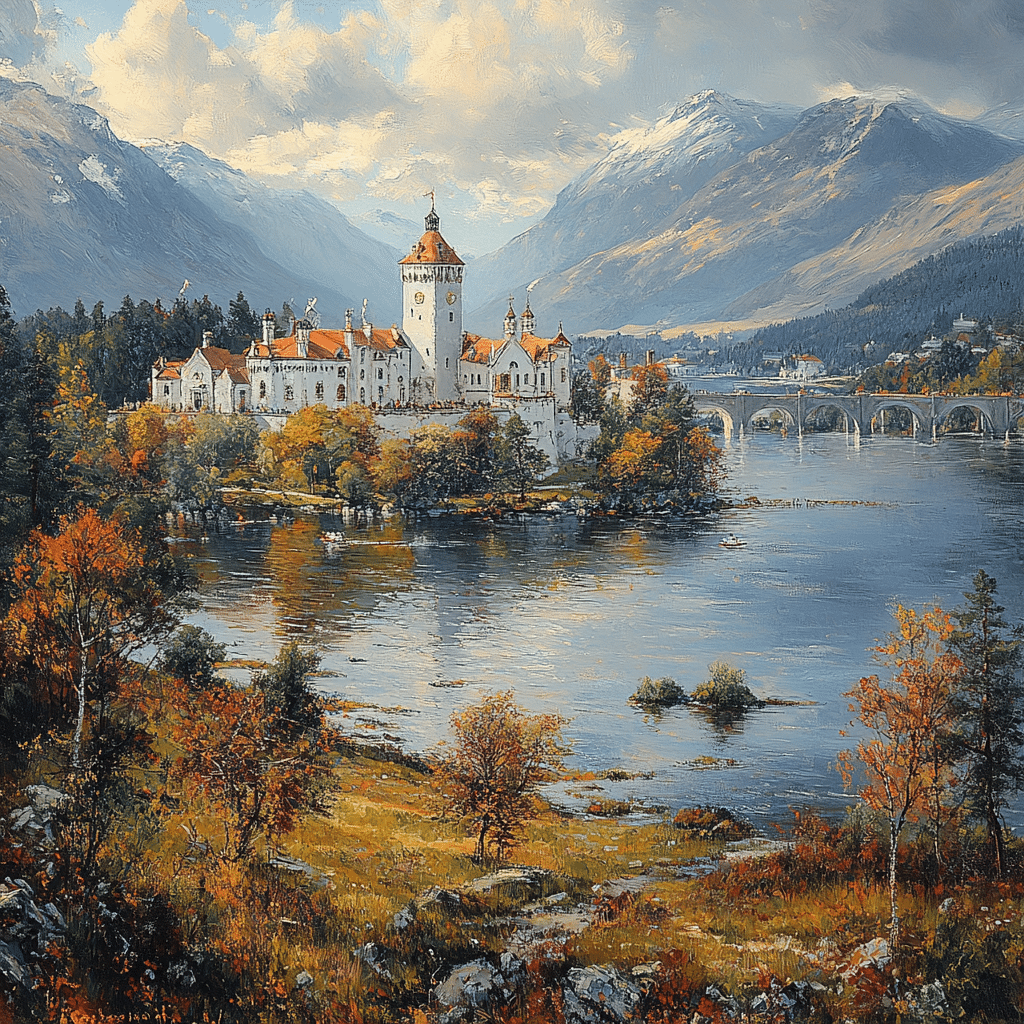Unveiling Fort Augustus: A Glimpse into History
Nestled at the southern tip of Loch Ness, Fort Augustus stands as a historic gem, weaving together Scotland’s vibrant past and its scenic allure. Originally constructed in the late 17th century, it provided a stronghold for British Army troops in the aftermath of the Jacobite uprisings. The military base, strategically positioned near vital military roads, played a key role in upholding peace in the region, especially during tense times. Today, while the echoes of its storied past resonate through its streets, Fort Augustus has transformed into a captivating destination that draws visitors from around the globe.
The fortification was named after Prince William Augustus, Duke of Cumberland, following extensive construction led by General Wade in 1729. Historical remnants, including a small section of the old curtain wall hidden behind the Lovat Hotel, remind us of the significant military past. Meanwhile, the stunning landscapes surrounding Loch Ness ensure that the fort’s beauty provides a juxtaposition to its military might. This blend of history and natural wonder makes Fort Augustus an irresistible destination.
Visiting Fort Augustus allows travelers to understand not just its historical context, but how each stone contributes to the narrative of Scotland. With its Gaelic name, Cille Chuimein, echoing tales of the past, one can’t help but feel the weight of history while meandering through this quaint village. As you stroll along the picturesque shores of Loch Ness, the enchanting atmosphere beckons you to explore the rich tapestry of culture and heritage that Fort Augustus embodies.
Top 5 Highlights of Fort Augustus You Can’t Miss
If you’re planning a trip to Fort Augustus, you won’t want to miss these five must-see highlights!
Opened in 1822, the Caledonian Canal is an engineering marvel connecting Fort Augustus to the Moray Firth. Particularly iconic is the flight of five locks at Fort Augustus, where you can marvel at the fluidity of boats navigating the steep elevation between Loch Ness and Loch Oich. Observing the operation of these locks is mesmerizing and a staple activity for visitors. Make sure to take a moment to appreciate the harmony between human ingenuity and nature at this remarkable site.
Once a Benedictine Abbey, Fort Augustus Abbey, dating back to the 18th century, retains its stunning architectural grandeur. Now functioning as a luxury holiday rental, the abbey’s serene gardens offer breathtaking panoramas of Loch Ness, making it an ideal spot for a peaceful retreat. Many guests find solace within its walls, pondering the quiet history that the structure holds. The tranquility and beauty of this site contribute significantly to Fort Augustus’ charm.
Standing as a poignant tribute, the War Memorial honors local soldiers who fought bravely in the World Wars. Perched at a high vantage point, it overlooks the tranquil waters of Loch Ness. This memorial not only pays respect to those who fought, but it also embodies the unyielding spirit of the community. Seeing it inspired a sense of connection between past and present, particularly as local residents gather during remembrance events.
Fort Augustus comes alive with its vibrant local economy, showcasing quaint craft shops and charming cafés. Notable is the Loch Ness Coffee Shop, where mouth-watering homemade cakes and specialty brews await visitors. Local artisans offer one-of-a-kind items, from knitted crafts to Scottish pottery. These shops provide perfect souvenirs to capture the essence of the Highlands and illustrate the area’s creative spirit.
Embarking on a Loch Ness Cruise is a quintessential experience in Fort Augustus. Companies like “Nessie Cruises” offer guided tours, weaving legends and facts about this mysterious lake, including tales of the elusive Loch Ness Monster. Knowledgeable guides share engaging stories, enriching the journey while visitors seek to unveil the secrets of the deep. Don’t forget your camera, as you’ll want to capture the stunning views from the water!

| **Category** | **Information** |
|---|---|
| Location | South-west end of Loch Ness, Scotland |
| Historical Context | Established as a military base in 1729 by General Wade after the Jacobite rising of 1715. |
| Name Origin | Renamed Fort Augustus in honor of Prince William Augustus, Duke of Cumberland. |
| Significant Structures | Original fortification constructed in 1729; remnants of Kiliwhimin Barracks; Fort Augustus Abbey (now a luxury holiday rental). |
| Current Status | The area is a quiet village with tourist attractions, particularly during summer months. |
| Cultural Significance | The Gaelic name for the village is Cille Chuimein, reflecting its historical roots. |
| Tourist Appeal | Popular destination for both summer visitors and quieter seasons; recognized for its picturesque scenery and village charm. |
| Key Features | Scenic location near Loch Ness, cultural heritage, remnants of historical structures, and vibrant local community. |
| Notable Events | Military significance during Jacobite wars, transformation into a tourist destination post-1818. |
| Accessibility | Accessible by major roads connecting to other parts of the Scottish Highlands. |
The Ecological Significance of Fort Augustus and Loch Ness
While history and beauty define Fort Augustus, its ecological significance can’t go unnoticed. The area thrives with biodiversity ranging from otters to dozens of bird species. Conservation efforts are essential in this region, as initiatives like the Loch Ness 360 Trail play a pivotal role in preserving natural habitats. The diverse ecosystems enrich the area and engage tourists interested in wildlife.
Fort Augustus sits at a crossroads of environmental challenges, including pollution and climate change. Ongoing efforts to celebrate and protect its rich ecological profile are critical. Local community organizations and environmentalists have joined forces to ensure the preservation of both flora and fauna. These joint initiatives make a true impact, cultivating a sustainable relationship between the area’s visitors and its environment.
As visitors traverse the landscapes near Loch Ness, they are reminded of the importance of safeguarding these natural habitats for future generations. The rich ecology underpins the allure of Fort Augustus, connecting its historical narrative with the landscape’s ongoing story. Investing in preservation guarantees each visitor helps leave a positive mark on this extraordinary gem in Scotland.
Fort Augustus in the Modern Era: Tourism and Sustainability
With tourism flourishing, Fort Augustus contends with the fine balance of attracting visitors while retaining its unique character. The village encourages eco-tourism and sustainable practices among local businesses, showcasing a commitment to preserving its cultural and natural heritage. Visitors can engage with diverse programs aimed at reducing plastic waste and promoting local produce.
Community-driven events further weave sustainability into the fabric of Fort Augustus. Local farmers’ markets allow artisans and producers to showcase their goods while fostering connections between residents and visitors. The unique blend of tourism and community spirit acts as a nurturing ground for sustainable growth, allowing Fort Augustus to thrive as a destination.
As 2024 approaches, Fort Augustus aims to serve as not just a picturesque village but a model of responsible tourism. By marrying historical preservation with modern needs, the community fosters welcoming experiences for those looking to explore the heart of the Highlands. The dedication to sustainability empowers both residents and travelers, signaling a promising future for this captivating location.

Embracing the Future
Fort Augustus stands on the brink of evolution. It’s not just the captivating views or the deep-rooted history that call out to travelers but a commitment to innovation and sustainability. With plans for recreational enhancements and continued community involvement, the village paves a way where tradition meets modernity.
Engagement in environmental issues illustrates Fort Augustus’ proactive stance in addressing modern challenges. Visitors are invited to join this tale of resilience, where the village breathes life into historical landmarks while embracing eco-friendly initiatives. The ongoing narrative unfolds, promising a legacy cherished by all who pass through its charming roads.
As Fort Augustus looks towards the future, it invites you to explore its breathtaking landscapes, rich history, and strong communal spirit. Whether you’re drawn by the enchanting tales or merely the stunning vistas, Fort Augustus stands ready to welcome you with open arms, embodying the very essence of Scotland’s cultural heritage.
Fort Augustus: The Historic Gem at Loch Ness
Curious Facts About Fort Augustus
Nestled at the southern tip of Loch Ness, Fort Augustus isn’t just known for its stunning scenery but also for its rich history. Originally built as a military fort in 1716, it was intended to control the Scottish Highlands following the Jacobite risings. But did you know this fascinating spot was named after Prince Augustus, the Duke of Cumberland? Talk about a historical homage! The fort’s strategic position made it an important military base — much like the Fosa de Las marianas, which guards its deep, mysterious depths.
Moving beyond its name, Fort Augustus is home to picturesque canals that draw boaters and tourists alike. The town features a series of locks that create a beautiful stairway effect, attracting visitors year-round. And speaking of quirky trivia, ever wondered which Foods That cause ear wax might lead to odd moments when enjoying your holiday snacks? Keep that in mind next time you indulge by the loch! The combination of nature, history, and a bit of humor makes Fort Augustus a must-visit.
Moreover, Fort Augustus boasts a fascinating connection to literature and culture. This area’s rich Scottish lore has inspired numerous tales, making it a popular subject for authors. Interestingly, early Scottish novels often explored themes of isolation and resilience. Much like Sam Melvilles stories, which depict ordinary individuals in extraordinary circumstances, the stories here encapsulate the essence of human endurance against backdrops of stunning nature. So, if you’re feeling adventurous, grab a book and let Fort Augustus pull you in with its timeless charm.
Lastly, local legends surrounding Fort Augustus would make for an intriguing read, blending myth with reality. Did you know the loch is said to house a creature that attracts countless enthusiasts and cryptid hunters? Just as people navigate their personal journeys, they often apply For a mortgage loan with dreams bigger than one can imagine. This juxtaposition of dreams, whether in business or in exploring the haunted loch waters, reflects the adventurous spirit that Fort Augustus embodies. So grab your camera and your sense of wonder — this historic gem at Loch Ness awaits!

Why is Fort Augustus famous?
Fort Augustus is famous for its rich history as a military base near Loch Ness and its striking scenery. The village buzzes with visitors and offers a glimpse into its past with remnants of the old fortifications and the picturesque loch.
Is Fort Augustus worth visiting?
You bet it’s worth visiting! The village has a charming vibe, especially in summer, and even during quieter months, it’s a lovely spot to escape the hustle and enjoy the stunning landscapes.
Is there still a fort at Fort Augustus?
There’s not much of a fort left now, but you can still see a bit of the old curtain wall behind the Lovat Hotel. The original fort was replaced and ultimately abandoned in 1818.
What was Fort Augustus old name?
The village was originally called Kiliwhimin until the early 18th century when it got its current name, Fort Augustus, after the Jacobite rising of 1715.
What famous buildings did Augustus build?
Augustus is known for building several impressive structures, including the famous Augustus Bridge and various temples and palaces across the Roman Empire that showcased Roman engineering and architecture.
What is the meaning of Fort Augustus?
The name Fort Augustus literally means “fort named after Augustus,” referring to Prince William Augustus, Duke of Cumberland. It’s a nod to the site’s military history.
Are there midges in Fort Augustus?
Yes, there are midges in Fort Augustus, especially during the warmer months. They can be quite a nuisance, so it’s wise to come prepared with some repellent if you’re visiting then.
What shops are in Fort Augustus?
Fort Augustus has a selection of shops catering to tourists, including souvenirs, local crafts, and essential goods, making it a nice place to pick up a unique memento.
How many locks are there at Fort Augustus?
There are five locks at Fort Augustus on the Caledonian Canal, and they’re a popular spot for visitors keen to watch the boats navigating the system.
How many people live in Fort Augustus?
The population of Fort Augustus is around 600 people, making it a small but welcoming community that thrives on tourism and local charm.
What is the oldest fort still in use?
The oldest fort still in use is the Tower of London, which has been a fortress and royal palace since its construction in the late 11th century and remains an iconic symbol of British history.
How long does it take to walk the Great Glen Way?
Walking the Great Glen Way takes about four to five days on average, depending on your pace and the trails you choose. The route stretches about 73 miles, offering breathtaking views all along the way.
What illness did Augustus have?
Augustus suffered from various health issues, including what is believed to be a combination of poor health related to his lifestyle and the stresses of political life during the tumultuous Roman era.
What caused Augustus’ downfall?
His downfall was mainly caused by political struggles and the social unrest in the late years of his reign when multiple challenges to his leadership emerged, leading to instability.
What was Augustus famous for?
Augustus is famous for being the first Roman emperor, establishing the Roman Empire’s foundations, and bringing a period of relative peace known as the Pax Romana after years of civil war.



